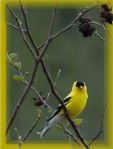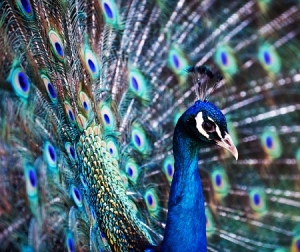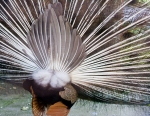[rockyou id=139733474&w=426&h=320]
 There are quite a number of other bird varieties at the sanctuary, many of which I have yet to catch a really decent photo of. The small birds flit across the marshes, and from tree to tree, or birdhouse to tree, in a flash of motion. The red-wing blackbird is plentiful here, as are the chickadees and small sparrows. On the far side of the swamp along the bushes lining the waterside of the trail we have seen small yellow finch (American Gold Finch maybe?).
There are quite a number of other bird varieties at the sanctuary, many of which I have yet to catch a really decent photo of. The small birds flit across the marshes, and from tree to tree, or birdhouse to tree, in a flash of motion. The red-wing blackbird is plentiful here, as are the chickadees and small sparrows. On the far side of the swamp along the bushes lining the waterside of the trail we have seen small yellow finch (American Gold Finch maybe?).
I am not a “birder” but I like watching the birds and trying to identify them. As I’m able to, I’ll be trying to capture the other varieties of birds at the sanctuary.
Green Heron
On June 19th in the early evening I noticed a bird fly into the sanctuary – it was just a flash of brownish colours in the reeds and grasses at the far side of the sanctuary. Initially I thought it must have been a female duck, but I was pretty sure the wing and body shape was wrong. As I scanned the shore area where I had seen the bird go, I couldn’t catch sight of it, and went back to photographing the landscape of the sanctuary.
When I arrived home and started going through the photos I discovered “the bird” in one of my photos. Not a terribly good shot of the bird because I wasn’t focused on it and didn’t realize it was there, and the far shore was just too far away for my lens to get a good close-up shot, even if I had known. It was enough to let me identify it though – it was a green heron. I’ve seen plenty of heron’s around Orillia – down near Kitchener Park and out in the canal area of Lagoon City, but not the green heron. This is my first sighting of one (which isn’t saying much since I don’t go out specifically to birdwatch.) Click the photo to see the larger version.
Green Heron Facts: All About Birds, Cornell Ornithology Lab
Peacock
 There are a pair of peacock at the sanctuary, two years ago (2007) there were peacock chicks. This year, we’ve been told there are some eggs in the peacock nest, so we wait in hope of seeing the babies again.
There are a pair of peacock at the sanctuary, two years ago (2007) there were peacock chicks. This year, we’ve been told there are some eggs in the peacock nest, so we wait in hope of seeing the babies again.
The male peacock’s long feathers make a fabulous display against his blue upper body. Something I have only witnessed at the sanctuary is the male peacock “vibrating” his open feathers. One doesn’t so much see the vibrations  as hear them – the sound is a very loud humming, with a bit of a “whooshing” sound mixed in. It took me quite a few minutes to realize where it was coming from. As he turns to and fro displaying his glory, the humming sound definitely draws your attention, then he turns and you get a wonderful view of the feathers covering his rear body. His rear feathers remind me somewhat of those of a turkey (not the wild turkey) and are a rich, milky brown, with snow white tufts that look somewhat like down feathers at the top, and speckled feathers towards the bottom.
as hear them – the sound is a very loud humming, with a bit of a “whooshing” sound mixed in. It took me quite a few minutes to realize where it was coming from. As he turns to and fro displaying his glory, the humming sound definitely draws your attention, then he turns and you get a wonderful view of the feathers covering his rear body. His rear feathers remind me somewhat of those of a turkey (not the wild turkey) and are a rich, milky brown, with snow white tufts that look somewhat like down feathers at the top, and speckled feathers towards the bottom.
The female (peahen) is less spectacular (which is generally the way with birds), but when the sunlight falls on her, the colouring on her head is quite beautiful; a rich blue/teal with bands of dark chocolate brown, white and black.
The chicks are yellowish on the underside, but a delicate brownish/beige on the top, with fine markings along the feathers. Their beaks are slightly pinkish with gray along the upper edges. These images of the babies were taken in 2007 (click to see a larger size version).
Visit the links below to find out more information on Peacocks.
National Geographic – Peacock Facts
eSSORTMENT: Facts About Peacocks by Christina VanGinkel
Pheasant
 There are a couple of pheasant varieties at the sanctuary. While the pheasants are similar in shape and size, their colouring is quite different. While one is bright yellows, oranges and reds (Red Golden?), another is darker browns and burgundy red (Ring-necked Pheasant), ones is gold and brown with very distinct markings (Reeve’s Pheasant) and still another is white and black speckled (Silver Pheasant).
There are a couple of pheasant varieties at the sanctuary. While the pheasants are similar in shape and size, their colouring is quite different. While one is bright yellows, oranges and reds (Red Golden?), another is darker browns and burgundy red (Ring-necked Pheasant), ones is gold and brown with very distinct markings (Reeve’s Pheasant) and still another is white and black speckled (Silver Pheasant).
The other day while visiting the pheasants I noted an awful lot of eggs scattered around the floor of the enclosure of the Ring-necked pheasants. They look just like brown chicken eggs. I’m not sure what they are doing scattered around the floor the floor, instead of in a nest though. I don’t know anything about pheasants, but almost all birds lay eggs in some form of nest, or in grass on the ground, together in a group – otherwise, how would they hatch? There seems no way the pheasant could incubate these eggs. In the photo gallery (other birds) are pictures of the male and femal ring-necked pheasants with the eggs scattered.
More about Pheasants:
Ring-necked Pheasants: National Geographic
Reeve’s Pheasant: Pheasant Club
Wild Turkey
There are a couple of wild turkey at the sanctuary too, though I’ve seen wild turkey along the trails in Orillia and in farm fields. For the most part, they run when you try to approach them, so I’ve only managed some “long distance” shots, and none terribly good. Early in the spring (2009) I found a dead one in the water at the edge of the pond. It took me a while to identify it, because the only thing visible was a spread of large feathers and the rest was submerged. I’m not sure what happened, but it wasn’t a pleasant sight. Though unfortunate, death, just as life, is part of nature.
Wild Turkey Facts – National Geographic
Other Bird Facts
Black-capped Chickadee: All About Birds – Chickadee Facts
Brown Sparrow: All About Birds – Song Sparrow
Red-winged Blackbird: All About Birds – Red-winged Blackbird
Tree Swallow: All About Birds – Tree Swallow




I’m trying to identify a bird that I took a picture of on my property. How would I go about doing this. It is not in my bird book. No one else seems to know either.